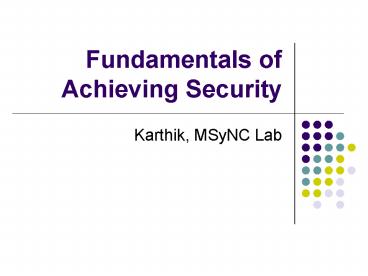Fundamentals of Achieving Security - PowerPoint PPT Presentation
1 / 16
Title:
Fundamentals of Achieving Security
Description:
Probability Theory Success, Failure, (In) Dependence, Distributions. Information Theory Entropy or Randomness, Ways to measure it, ... Provable Security ... – PowerPoint PPT presentation
Number of Views:22
Avg rating:3.0/5.0
Title: Fundamentals of Achieving Security
1
Fundamentals of Achieving Security
- Karthik, MSyNC Lab
2
Goals of Security Mechanisms
- Privacy Secrecy of data
- Encryption
- Authentication Validity of entities involved
- Signatures, Passwords
- Integrity Validity of data
- Hash, CRC
- Non-Repudiation Establishing source of data
- Undeniable Signatures
3
Mathematical Ideas
- Various fields of mathematics are used
- Probability Theory Success, Failure, (In)
Dependence, Distributions - Information Theory Entropy or Randomness, Ways to
measure it, - Complexity Theory Algorithms, Running time,
Complexity classes, - Number Theory Integers, Primes, Factoring,
- Abstract Algebra Groups, Fields, Rings,
4
Shannons Theory
- Shannon, Bell Labs, 1949
- Mathematical Theory of Communication
- Communication Theory of Secrecy Systems
- Unconditional Security
- If security is guaranteed even with unbounded
resources - Provable Security
- Prove security to some well studied problem that
is considered difficult (NP complete). - Computational Security
- The best known attack requires N operations where
N is very large
5
Shannons Theory Contd
- Perfect Secrecy
- Prefect Secrecy is achieved if
- i.e. if the probability of plaintext x is the
same as its a posteriori probability given
cipher text y - Key Equivocation
- Measure of the information about the key revealed
by the cipher text - Unicity Distance
- Gives the amount of cipher text needed to reveal
the key, for a language with redundancy D, the
unicity distance U is
6
Basic Operations in Ciphers
- Substitution
- Substitute one plain text symbol with an unique
cipher text letter - S-box, Non-Linear Codes
- Permutation
- Rearrange the plain text symbols
- Permutation Functions, MDS Codes
- Product Cryptosystems
- Use Substitution and Permutation one after
another - Fiestel Network, All Modern Ciphers
7
Avalanche Effect
- This term was first coined by Fiestel to describe
the result of substitution and permutation on the
input plain text - As the plain text is processed by the cipher the
each layer amplifies the pattern of 1s, the
result is an unpredictable AVALANCHE that results
in an average of half 0s and half 1s in the
output - This makes the output of the cipher appear random
and hides the distribution of the plain text and
the Key in relation to the cipher text.
8
Effect of Compression
- Compression reduces the redundancy
- This makes the distribution of the plain texts in
the source more even. Thus reducing the
information leaked in each cipher text block is
reduced. - Compression increases H(P) this make guessing the
key more difficult
9
Any New Ideas ?
- Which source coding techniques can be useful in
providing security
10
Use of Channel Coding In Cryptography
- Channel Coding has been used in several different
scenarios to provide security - Examples
- Encryption
- McEliese Cipher
- Secret Error Control Coding
- Signing
- Ximmei Scheme
- Authentication
- Aumann and Rabin Scheme
11
Reason for using Channel Codes
- Usually both security and channel coding is
needed by applications - Wireless applications
- Channel codes may be good building blocks of
ciphers - Would reduce hardware costs
- Some similar applications already exist
- MACS and ECC both detect errors
12
Usage of Channel Codes in Security machanizms
- Difficulty in decoding a General Block Code
- The problem of decoding an arbitrary code is
considered to be NP hard. This property is used
as follows - Select a good linear code
- Keep the generator polynomial of the code secret
- Encode the message to be sent
- In McEliese System
13
Other Techniques
- Burst Error Correction Codes
- Use in Authentication
- Signing
Problems In using Channel Codes
- Adds redundancy
- Codes vary according to the medium used
- Simple combinations are not secure
14
Use of Codes in Current Ciphers
- Non-linear Codes as S-boxes
- S-boxes are a very important part of modern block
and stream ciphers. - Provide non-linearity and help defend against
differential and linear cryptanalysis. - Properties needed are Non-linearity, resilience
and auto-correlation
15
MDS Codes in Mix-Column of AES
- The Mix-Column operation of AES (rijndael) has
been designed based on MDS codes. - The security is measured using a term called
branch number. This is the measure of active
bytes after each round.
16
Ideas on Applying Channel codes ?































